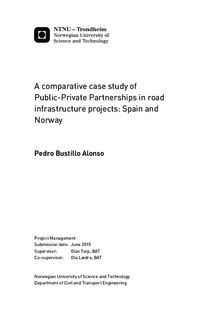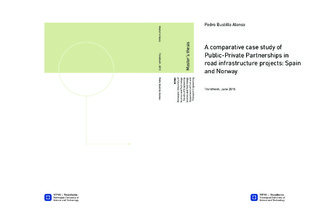| dc.description.abstract | Public-Private Partnership scheme in infrastructures is not a new concept that has come up in the last years; this is a strategy that has evolved adapting to the new necessities and requirements of the society. Over the last years, PPP has been more and more broadly used in many countries as a mean to achieve the numerous demands of a society within context of budgetary constraints. Norway has also initiated projects under PPP arrangements in 2001 when the first of the three road pilot projects was approved. Further, there are also planned three new road projects in the mid -term by the authorities, proving its bright future to support the development of infrastructures in Norway.
For this purpose, it is important to assess the current performance of the three pilot projects to ensure the feasibility of the PPP scheme. The proposal made for this analysis is to compare the Norwegian PPP frame with another country with more relevant experience in the field. Therefore, this thesis has proposed to conduct this using Spain as reference owing to its long and well-established experience after conducting more than 3000 km over 45 years.
Two key issues that define whether a PPP projects will be satisfactorily performed or not, are the procurement procedure conducted and more precisely the risk allocation. The former means the channel though which the potential of a certain project is managed while the latter distributes responsibilities and meaningful financial burdens between the stakeholders according to the principle of PPP of risk sharing in a long-term agreement.
In order to answer these challenges, the aim of this thesis seeks to:
1. Which are the main differences, if there are some, observed between the procurement procedures in PPP projects of Spain and Norway?
2. How do the Norwegian and Spanish PPP projects follow the procurement recommendations given by the European PPP expertise centre (EPEC)?
3. How the existing risks are allocated between the private and public sector in Norway and Spain and how is the risk allocation different between the countries?
Answering the questions outlined above has required an extensive and comprehensive literature review that includes economical, political, legal, technical and sociological perspectives around PPP arrangements. This has contributed to draw a solid ground theory to subsequently analysis and assess a group of 15 road projects in Spain and the three Norwegian pilot projects which were all conducted during the same time frame. Thus, a review of the procurement procedures used for each scenario were break down with the help of the EPEC guide to guidance to conduct, implement and deliver PPP in Europe as a reference for an ideal procedure to manage these arrangements. Special attention has been devoted to the risk allocation which could be distinguished as the one of the most relevant parts owing to the vast number of researches and studies already carried out.
Discussion launched before have focused on the consequences of the procedures and risks allocations selected within a global perspective that includes the economic downturn and the political context in the countries. The discussion also covers the distribution of risks realized. Finally, a conclusion is made discussion and some suggestions are suggested to strengthen the Norwegian PPP model. | |

